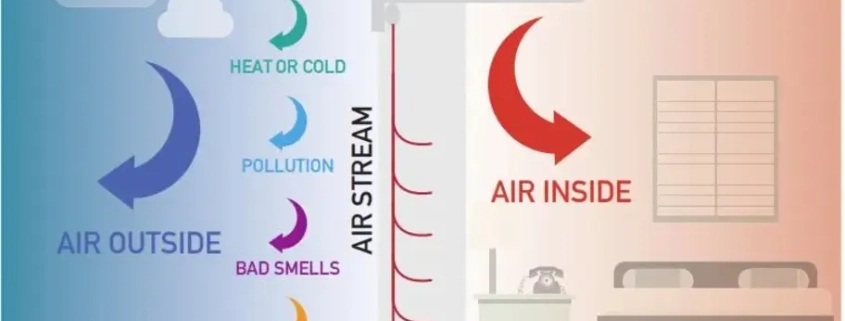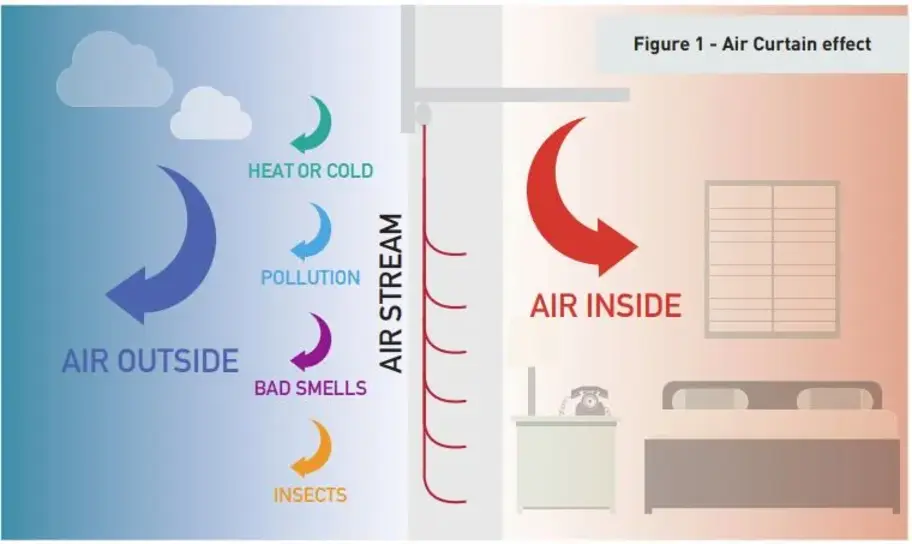Air Curtain Basics | What is an Air Curtain + How Does It Work?
Air Curtain Basics | What is an Air Curtain + How Does It Work?
A device that creates an air barrier across a door’s whole opening to divide two environments is called an air curtain.
Typically, the air curtain keeps flying insects, odours, humidity, dust, and debris out of the conditioned interior air and keeps it separate from the outside air. Air barriers, fly fans, air shields, and air doors are some other names for air curtains, depending on the sector or even the area in which they are used.
How does an air curtain work?
Typically, an air curtain is installed indoors above a doorway, where it draws air into the device’s intake.
This air can be ambient, i.e., taking the interior air from the inside of the building at whatever temperature that temperature is, or you have the option of heated air curtains, either by electric or hot water heaters, blowing warm air and blocking frigid winter winds.
Air curtains create a laminar airflow, which is produced as a result of this air being driven and accelerated through a small outlet that runs the length of the air curtain. To attain optimal performance, the air discharge angle can be modified using the adjustable blades that come within the air curtain.
Air must travel farther until it reaches the floor when the discharge angle increases.
If the discharge angle is too large, the air curtain won’t be adequate to prevent any wind from infiltrating near the floor because the air’s velocity drops as it moves farther away from the curtain. The air exiting the unit won’t have enough downward force to prevent a substantial gust of wind from entering if the discharge angle is too slight.
Do air curtains really work?
Definitely! All studies and experiments have shown that air curtains work. When an energy-efficient air curtain is correctly installed, it saves a lot of energy while keeping the entrance area temperature protected, comfortable, and free of drafts, insects (this is why air curtains are sometimes called fly fans), smells, and so on from the unconditioned outside air, which can be cold or warm air depending on the time of year.
Air curtains create temperature and environmental separation
In one line, “They create an effective seal on a doorway via a high velocity air flow discharge or air flow stream that ensures environmental separation for doorways or entrances to buildings.” This airflow can be ambient or heated, depending on the requirements of the separate environments.
When are air curtains commonly used?
Air curtains prevent cold air from entering everything, from an employee entrance or customer front door all the way to large loading bay doors. The air curtains create a recirculating, clean air invisible air door as such, resulting in considerable cost savings on the heating energy bills. These energy savings can be up to 40%, depending on the door usage characteristics, as they effectively separate environments.
Used everywhere from food service industries, restaurants, hotels, shops, and cold storage locations to busy warehouses to ensure environmental separation.
Retail applications
In a retail setting, air curtains are frequently placed above a store entryway or other commercial front door. These retailers consistently see foot traffic during peak hours. Even when the business is steady, opening and closing doors all the time could overload the building’s HVAC system and let in insects, dirt, vapours, humidity, and excessive heat or cold.
Warehouses or production facilities
Warehouses are the industrial version of retail. The continuous in-and-out movement of goods is common. The loading dock doors can let in a variety of undesirable elements, such as dust, odours, insects, significant temperatures, humidity, and debris, even if they are opened for a brief period. For those who work close to the doors, it can be unpleasant because they will freeze in the winter and sweat in the summer.
Air curtains for industrial use contribute to a more comfortable environment. They can also lead to increased worker comfort, productivity, and safety. In congested warehouse facilities where forklift traffic is high, visibility is critical, as air curtains create an invisible barrier of air—no dirty strip curtains to create safety hazards and provide a poor air seal.
Food production facilities and restaurants
Facilities that produce and serve food are subject to strict regulations and must maintain the highest standards of hygiene. They are also particularly appealing to insects because of their prep areas and delivery doors. Because insects and strict hygiene standards don’t mix well, air curtains are a great way to significantly reduce flying insects from entering restaurants and other eating places. Air curtains are commonly used to keep hot, humid air out of the interior, in addition to keeping insects out. Air curtains complement these locations very well.
Hospitals, schools, or offices
Despite their distinct differences, all three locations see a steady flow of people entering and leaving through a variety of doors. They are all alike in that they invite outside air, insects, and vapours inside when their doors are open. Entrance doors, delivery entrances, loading docks, and other doors can all benefit from air curtains to keep out the elements, ensure energy savings, and improve workflow.
Ambient or hot air?
Air curtains create an invisible barrier; they can do this with ambient air, which is the air from the room that the unit is installed in. The building’s primary HVAC system provides the heat or chilled air to the room, and this is passed through the unit at a high velocity.
The other option is heated air curtains, which heat the air with a heating element. We have a dedicated webpage here for our electric heated air curtains or hot water heated air curtain units.
Understanding the basics of air curtains
There are three main considerations to ensure that all air curtains work in the correct manner. These are
An air curtain unit’s length should never be shorter than the door width if installed horizontally above the door.
An air curtain unit’s length should never be shorter than the door height if installed vertically at the side of the door.
Depending on the site conditions, the air curtains’ air velocity must meet the specified speed (usually the discharged air reaches a minimum of 2.3 metres per second at floor level). As a result, when selecting air curtain requirements, it is important to consider the height of each proposed door or opening as well as the prevalent interior and exterior climatic conditions that units’ air velocity may have to tolerate.
Energy Savings
A study by Cardiff University showed that in a typical convenience store in the UK, the heating load for the base case was 48 W/m2 per year. Both an air curtain and an automatic door can significantly reduce the heating load to 11 W/m2 per year and 19 W/m2 per year, respectively. This was a 77% reduction in heating energy consumption and considerable cost savings and a great return on investment.
Source Cardiff University- Investigating the Energy and Thermal Implications of Installation of an Air Curtain
Fumes, dust, exhaust, and debris control
Air curtains can provide a barrier that limits the penetration of undesired pollutants in locations with high levels of dust, odours, and debris. Air curtains keep these elements from accessing locations where people work or congregate, improving overall safety. From a customer’s entrance door in a restaurant to shopping centres or warehouses, the ability to block these detrimental substances in the outside air is crucial.
Buying an air curtain? Here’s what to look for:
Negative air pressure
If there is negative air pressure due to mechanical exhaust or stack pressure, the building’s air curtains will experience reduced effectiveness.
Installation requirements
Note the clearance to the ceiling on the side of the opening where the air curtain will be installed, as well as any obstructions above the doorway or entrance. Air curtains often require a minimum distance to work correctly and ensure maximum wind-stopping capability.
Vertical Installations
Mounting air curtains vertically places the unit’s operating noise at ground level, which should be considered. To protect and prevent damage to the air barrier, it is strongly recommended to install a barrier or bollards that shield the air curtains from potential damage caused by forklifts, etc. Here is our dedicated webpage on vertical air curtains.
Conclusion
If you require any more advice or need to clarify anything on air curtain basics, what is an air curtain or how air curtains operate, please don’t hesitate to contact us at Flexiheat UK.

 Flexiheat UK
Flexiheat UK
 Flexiheat UK
Flexiheat UK Flexiheat UK
Flexiheat UK